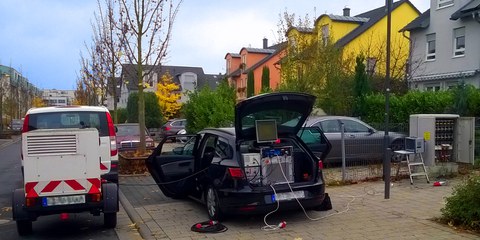Power Quality
Ensuring adequate power quality is a basic requirement for the trouble-free operation of all devices connected to the grid, from computers to photovoltaic inverters. In addition to limiting the emission of interference, this also requires the guarantee of a certain immunity to interference. The current and voltage quality is described by various parameters such as harmonics, flicker or unbalance and requires specific methods for their measurement. The correct and accurate measurement depends not only on the correct implementation of the measurement methods, but also on the accuracy of the entire measurement chain, especially the external transducers that may be used.
The research in the Power Quality working group focuses on the following topics:
- Various aspects of noise emission and immunity in the range less than 2 kHz (harmonic) and in the range between 2 kHz and 150 kHz (supraharmonic)
- Comprehensive analysis of accuracy when measuring current and voltage quality
- Method for efficiently evaluating large amounts of power quality measurement data
Through participation in various national and international committees, regular conference contributions as well as the implementation of seminars, the research results are made accessible to a broad public.
Projects
- Influence of electric vehicles and photovoltaic inverters on the quality of current and voltage (harmonic, supraharmonic, unbalance) in the public low-voltage grid (ElmoNetQ)
- Probabilistic modelling of harmonics emission in the low voltage network
- Origin and spread of supraharmonic in the low voltage network (measurement and modelling)
- Analysis of the conducted immunity of household appliances in the range between 2 kHz and 150 kHz based on model households
- Internet-based platform for the international exchange of harmonics emission measurements from household appliances; PANDA (equiPment hArmoNic DAtabase)
- Verification of standard conformity of measuring instruments according to IEC 61000-4-30 Ed. 3
- Metrological determination of the frequency-dependent network impedance in low-voltage networks
- Method for measuring the frequency-dependent transmission behaviour of voltage transformers
- Measurement device independent storage of measurement data of current and voltage quality as well as approaches to their easy visualization in web applications
- Efficient methods for the cross-location assessment of current and voltage quality as well as the automated identification of long-term trends, seasonal fluctuations and sudden changes in large amounts of data.
- Development of methods for calculating emission limit values proportional to output for large customer and producer plants (harmonics, unbalance)
- Analysis of grid feedback from charging stations of electric vehicles and PV inverters
- Coordinated power quality measurements in public networks (further information)
contact person
 © Changzhi Photo Gallery
© Changzhi Photo Gallery
Mr Prof. Dr.-Ing. habil. Jan Meyer
Professor for electrical power quality
Send encrypted email via the SecureMail portal (for TUD external users only).
Certificate of DFN-PKI for encrypted email communication.
Valid until: 08.02.2021
Visiting address:
Toepler-Bau, Room 136 Mommsenstraße 10
01069 Dresden

